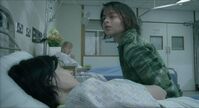The protagonist is a juggler and an imaginative painter. As the so-called art comes from life, there are shadows of life everywhere in her paintings, and the dream that dominates the whole story is a two-dimensional world constructed by all her paintings, and she is the god and savior of this world.
Because of the quarrel with his mother and the mother's illness, the protagonist's heart received a great blow. He apologized for his lack of courage and regretted his rebelliousness, and the materials in his paintings constituted such a dream. She needs to convince herself in this dream to save this pure and balanced two-dimensional world that belongs to her (that is, to save her inner balance). This is similar to a psychiatrist giving a patient hypnotherapy, but she is completely spontaneous.
In addition to this level, there is something more imaginative, even enough to add the word "science fiction" to the genre column of this movie. We often use the analogy between the three-dimensional world and the two-dimensional world when we think about the four-dimensional world and the three-dimensional world. This movie just looks at the three-dimensional world from a two-dimensional perspective. The people and monsters in the dream are two-dimensional creatures, they talk nonsense, they are stupid and ignorant, they can't see the three-dimensional world that their god (the protagonist) can see through the window, just like we can't see the concrete four-dimensional world. When another dark protagonist is tearing up and burning these paintings, their world will face the end, and this time their god, the protagonist, must save the world. The interesting thing is that this seems to reflect a bold assumption that things in the low-dimensional world will also affect things in the high-dimensional world. After the protagonist saves the two-dimensional world, real life is also saved! The protagonist's mother's surgery was a success! This can't help but remind me of Jung's principle of synchronicity.
Since the main line of the film is the dream, Freud's analysis method must have been applied in a large number of reverse directions in the film, so I will not analyze them one by one. For example, the protagonist puts the guilt that he does not dare to apologize to Valentine to solve it. Disguised as a festival between him and his tower.
In addition to the above-mentioned aspects, there are some interesting images and educational meanings, which I will not talk about. Finally, I will talk about my understanding of the image of the mirror mask. In the play, everyone in the dream is wearing a mask, and the protagonist is the only one who doesn't wear a mask. Everyone thinks he is abnormal (rethinking, do we often think that people who are different from us are abnormal people? Maybe These people will have better abilities.) In the end, the mask she must wear is a mirror mask, the mask itself is a thing that blocks her true expression and misleads others, and the mirror mask allows other people wearing masks. When people see the wrong information they give others, this is quite the demeanor of a sage.
There are still a lot of remarkable things about this movie, but I have said that enough. The writing is not good, and writing something is also impetuous. Maybe it is not clear enough, everyone forgive me.
View more about Mirrormask reviews











